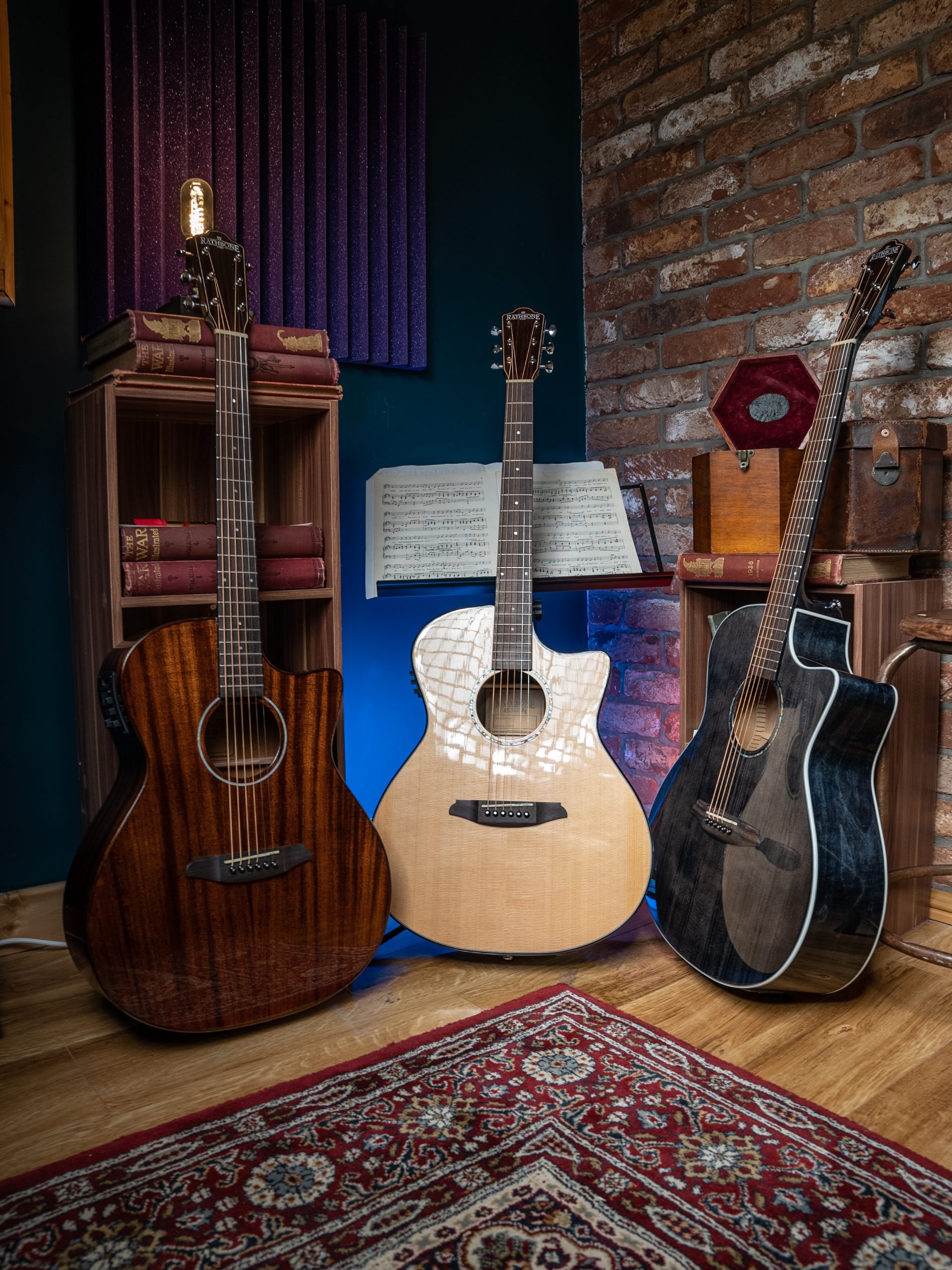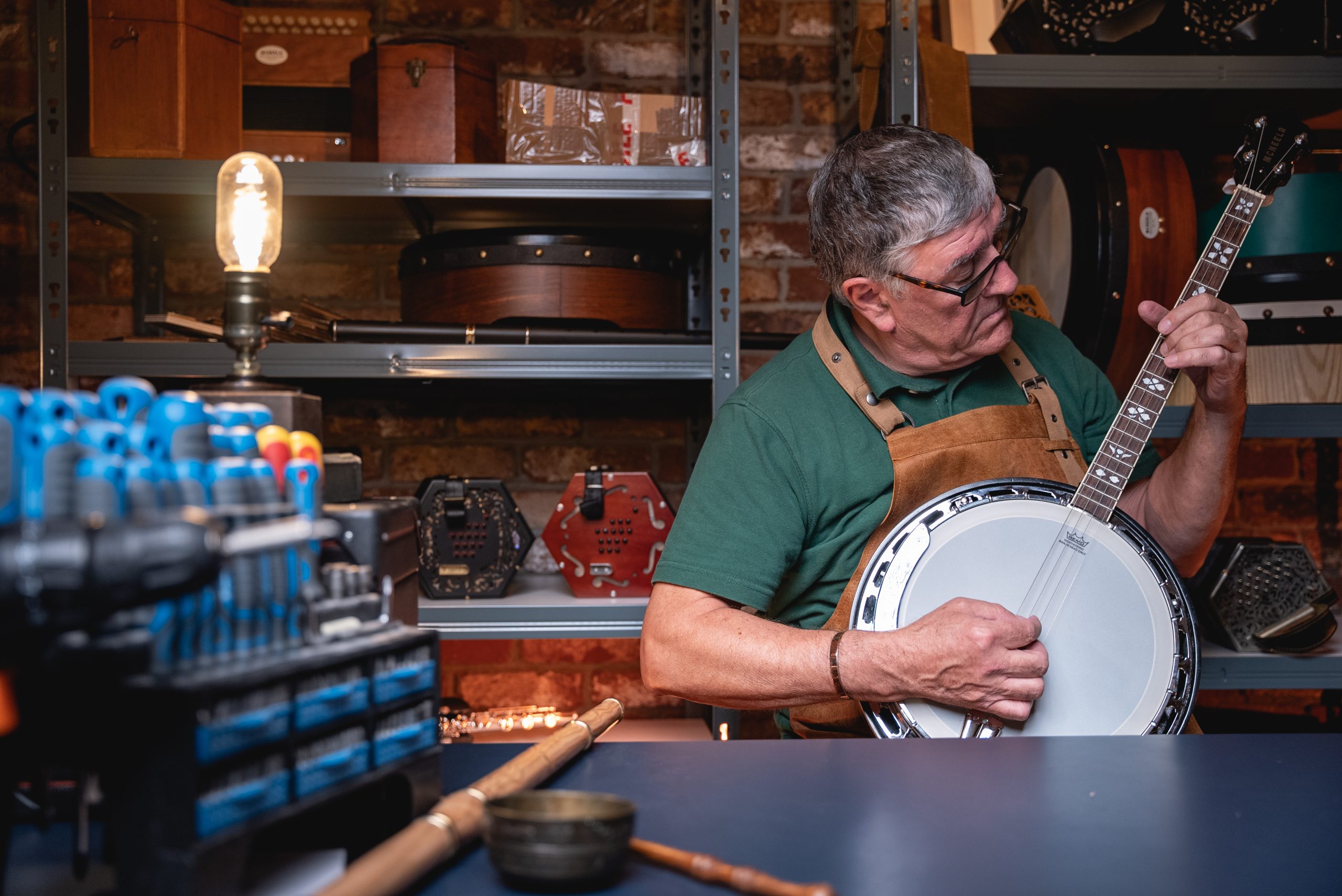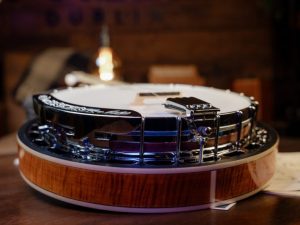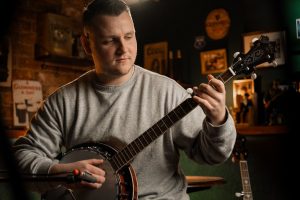
Easy or Hard to Learn? · First Steps · Quick Answers · How to learn faster.
-
- How hard is it to learn the banjo? Quick answers, learning difficulty & how to start.
- Learning curve: most players get first tune or chord groove in 1–2 weeks with daily 10–15 mins.
- Big unlocks: right-hand pick control, economy of motion, and clean fretting around frets 1–7.
- What’s in this guide: skills you need, common hurdles, 30-day plan, and setup tips.
Most beginners ask the same thing: is the banjo hard to learn? The honest answer is encouraging; no, as long as you start with the right basics and keep practice short and regular. Tenor banjo in GDAE puts Irish melodies neatly under the fingers; plectrum in CGBD begins with simple, repeatable rhythm patterns. With 10–15 minutes a day, many players get a first tune or a steady comping groove within 1–2 weeks.
Everything You Need to Know About Learning the Banjo
There are two main types of 4 string banjos: the Irish tenor banjo and the plectrum banjo. Keep reading to learn more about the differences between these two instruments.
Is Banjo hard to learn?
Not if you keep things simple. Focus on tiny down-up strokes with the pick, clean fretting around frets 1–7, and a relaxed posture. Tenor’s melody shapes are logical; plectrum’s rhythm patterns are easy to repeat. The curve is friendly for absolute beginners and even kinder if you’ve tried fiddle/mandolin (tenor) or basic guitar strumming (plectrum).
Are 4-String Banjos Good for Beginners?
Absolutely. Four-string banjos are ideal for beginners and are often the most accessible entry into the banjo family, especially the Irish tenor banjo. A 17-fret tenor offers the most compact feel to begin with; a 19-fret model adds range once you’re comfortable.
4-String vs 5-String: Which Is Easier to Learn?
Different paths: Irish melody: 4-string tenor (GDAE). Bluegrass/old-time: 5-string (Open G). For full differences, see this 4-string vs. 5-string banjo comparison.
What is an Irish Tenor Banjo?
The Irish tenor banjo is the name given to the most popular style of banjo played in traditional Irish music today. Historically it is not an indigenous Irish instrument however.
The Irish tenor banjo is a short neck 4 string banjo that typically features a 17 fret or 19 fret scale length and is tuned to GDAE – one octave lower than the Irish fiddle and mandolin.
What is a Plectrum Banjo?
The plectrum banjo is a four string banjo that is more commonly associated with jazz. Larger than tenor banjos, these 4 string banjos typically have the same scale length, head size, and fret count as five string banjos.
Like the tenor banjo, it is played with a plectrum or pick, rather than fingerstyle (like a 5 string banjo). The traditional tuning for a plectrum banjo is CGBD.
Tenor vs. Plectrum
Two 4-string paths: tenor for melody; plectrum for jazz comping and chord-melody:
- Tenor (GDAE or CGDA): melody instrument for jigs, reels and hornpipes; flatpicked with compact positions.
- Plectrum (CGBD): jazz/Dixieland companion; steady comping and chord-melody with a pick.
Is a 4 or 5 String Banjo Better for start learning?
Comparing a banjo with 4 strings and a banjo with 5 strings is like comparing a concertina and an accordion. They may seem like the same instrument to some, but in reality they operate differently and require a different playing technique.
Neither instrument is better. It really depends on which which style of music you want to play:
- If you want to play traditional Irish music such as jigs, reels, hornpipes and other tunes, a four string tenor banjo is the best instrument for you. Shop a 4 string tenor banjo here.
- If you’re interested in playing jazz then you’ll need a plectrum banjo.
- If you want to play bluegrass or country music, a five string banjo will help you achieve your desired sound. Shop a 5 string banjo here.
Photo by Robert Linder on Unsplash
How Long Does It Take to Learn the Banjo?
Wondering how hard is it to learn the banjo and how long it takes? Here’s a realistic timeline:
- 1–2 weeks: a full tune (tenor) or a steady four-to-the-bar comp (plectrum).
- 6–8 weeks: comfortable slow-session tempo with daily 10–15 minutes.
- 3–6 months: confident rhythm, basic ornaments (tenor) or two comping feels (plectrum).
Consistency beats length: daily short sessions are better than one long weekly practice.
Is the Banjo Harder to Play Than a Guitar?
Definitely not. The coordination required is similar, but the banjo often needs less finger movement. In Irish music the tenor banjo is a melody instrument, so early practice can focus on one string at a time, which simplifies the first steps.
Note: Six string banjos, also known as guitar banjos are, as the name implies, banjos that feature 6 strings. They are played using the same tuning as a standard guitar. Tuned to EADGBE, it’s a handy instrument for guitar players who don’t want to have to learn new fingerings or a new playing technique.
Some banjo players disapprove of these instruments and frown on their use, claiming that you might as well just play a guitar instead, but six string banjos have their own unique sound and are a separate, distinct instrument.
Check out the video below from Jens Kruger to learn more about these fascinating instruments:
Learning After Guitar: What Actually Changes
Your rhythm, timing and chord sense transfer nicely. What’s new is a shallower pick depth, a shorter scale feel, and using a strap so the neck sits steady while the right hand learns a lighter touch. If you want to keep guitar shapes with a banjo voice, a 6-string banjo (EADGBE) is an easy crossover; if your goal is Irish or jazz, stick with tenor/plectrum.
Why Banjo Is Easier Than You Think
Short, regular practice wins. Keep your hands relaxed, play slowly, and use simple patterns; you’ll sound musical faster than you think.
5-String (Bluegrass/Scruggs): Easy Roll Patterns. Use small picking patterns (“rolls”) over simple chords like G–C–D. Start on open strings and go slow; you’ll be able to back a song soon.
5-String (Clawhammer): The Bum-Ditty Groove. Down-pick with the finger, then the thumb hits the 5th string. Begin on open strings; add easy hammer-ons later. The groove comes quickly.
Tenor (GDAE): Tunes Fall Into Place.Same note layout as fiddle (just lower), so Irish tunes map naturally. Light pick, short strokes, slow tempo; full tunes come together fast.
Plectrum (CGBD): Simple, Repeatable Strums. Four-to-the-bar with gentle down-up strums. Add tiny chord slides for flavor. With short, steady sessions, you can back a song in week one.
6-String (Guitar-Banjo): If you play guitar, your chord shapes already work. Focus on right-hand feel and muting extra string ring.
Essential Banjo Skills: Learn These First
From zero to playing, we recommend focusing on these skills to learn banjo more easily:
- Pick control: show ~2–3 mm of pick (or relaxed nail for clawhammer); keep the motion tiny.
- Timing: count aloud or tap your foot; 70–90 bpm is plenty to start.
- Fretting comfort: neutral wrist, thumb behind the neck; prioritize clean notes over speed.
- Chord economy: learn I–IV–V in two keys + one movable shape (F-shape or D-shape on 5-string; closed shapes on 4-string).
- Micro-practice: 3 to 5-minute blocks beat one 15-minute block for building automatic motion.
If you’re ready to start, here’s a simple path that keeps things fun and consistent.
How to Learn Banjo: 30-Day Beginner Plan
If you want to learn banjo the easy way, start small: learn to play banjo with 10–15 minutes a day and a light pick touch. Aim for clean tone, steady timing, and by day 30 to play one full tune and back two simple songs at a slow tempo.
30-Day Banjo Beginner Plan
Week 1 — Set Up & First Sounds
- Posture: relaxed shoulders; comfortable sitting/strap.
- Tune with an app, then match 1–2 notes by ear.
- Right hand: one simple pattern (down-up strum, basic roll, or clawhammer “bum-ditty”).
- Left hand: two easy chords (I and V) or a short one-phrase melody.
- Daily: 5 min timing (metronome 70–90 bpm), 5 min pattern, 5 min chords/melody.
Week 2 — Add a Simple Pattern, Smooth Changes & Timing
- Add the IV chord and practice clean chord changes.
- Learn one major scale (slow and even) or a single-string walk.
- Play along to a slow backing track or metronome for 5–10 min.
- Record a 30-sec clip at week’s end.
Week 3 — Second Pattern & Full Sections
- Add a second right-hand pattern (e.g., alternating roll or down-up-mute strum).
- Link A + B sections of a tune; keep it slow and steady.
- Micro-technique: pick depth ~2–3 mm, fret close to the wire, relax thumb.
Week 4 — Put It Together & Polish
- Play one full tune and back two songs with steady timing.
- Add simple dynamics (soft/loud) and tiny fills between phrases.
- Quick setup check: comfy action, fresh strings, tuner handy.
| Week | Focus | Practice Plan |
|---|---|---|
| Week 1 | Set Up & First Sounds |
|
| Week 2 | Add a Simple Pattern, Smooth Changes & Timing |
|
| Week 3 | Second Pattern & Full Sections |
|
| Week 4 | Put It Together & Polish |
|
Daily rule: Small, daily sessions beat long, rare practice. Comfort first, speed later.
What you need: tuner app, metronome app, light pick (or natural nail), armless chair.
It can take time to coordinate both hands, but it isn’t harder than learning guitar; many players find banjo easier because common tunings and repeatable patterns give quick wins.
Ready to Choose a Banjo?
If you’re looking to buy a banjo then look no further. Here at McNeela Instruments we stock only the best banjos. Whether you’re looking for a 4 string banjo or 5 string banjo we have something for everyone. We also sell an exciting range of bouzoukis, mandolins and guitars.
Still have a few what-ifs? Here are quick answers beginners ask.
What’s the easiest banjo to learn?
If your goal is to learn banjo for melodies, a tenor banjo (4-string) feels very natural for Irish tunes. If you want to sing songs or play bluegrass, the 5-string banjo clicks quickly once basic rolls settle. The real answer to “easiest banjo to learn” is the one that fits the music you’ll actually play.
How hard is it to learn the banjo?
Not as hard as you think. With relaxed hands and short daily practice, most beginners make musical sounds fast. The main hurdle is coordinating a right-hand pattern with left-hand fretting, but it improves quickly.
How long does it take to get good at banjo?
- ~30 days: one simple banjo tune and backing two easy songs at slow tempo.
- 2–3 months: smoother chord changes and a small set of go-to patterns.
- 6–12 months: comfortable jams at moderate tempos.
Everyone’s different, but consistency beats marathon sessions.
Is mastering the banjo difficult? Do I need another instrument first?
Mastery takes years (like any instrument), but early wins come fast. You don’t need to learn another instrument first. If you already play guitar, piano, or fiddle, your timing and ear will help, but it’s optional.
Learning banjo after guitar: where should I start?
If you want familiar chord shapes with a banjo sound, try a 6-string banjo (guitar-banjo). If your target is Irish or jazz accompaniment, go tenor/plectrum and keep pick strokes small and light. For bluegrass, jump to 5-string and learn one roll pattern plus G–C–D.
Can I teach myself to play banjo?
Yes. Many players are self-taught using a tuner app, metronome, and beginner banjo lessons or tabs online. A monthly check-in with a teacher (in person or by video) speeds up your technique and fixes posture/ setup sooner.
What helps me learn banjo faster?
- Strings: lighter standard sets usually feel easier at the start.
- Setup/Action: ask for low, clean action. It’s the biggest shortcut for beginners.
- Strap & balance: a stable neck helps your right hand learn faster.
- Practice routine: 10–15 minutes a day, slow and relaxed. Micro-practice.
- Timing tools: use a metronome or backing tracks from day one.
- Record yourself: 30–60 sec clips reveal easy fixes for your next session.











Share your thoughts
I like the Tenor Banjo. I like playing melody leads and just sitting and plucking along on my TB. Thanks for this feature. Hard to find much on Tenor Banjos and even less where I live here in Carolina Beach, NC, USA. Everything here is five string. Thanks!
You're more than welcome John. I'm glad to be of help. And you're right, there's a lot of information out there on five strings, and a lot of confusion around 4 string banjos too. If you have any further questions be sure to get in touch, I'm always happy to help. Keep up the banjo playing!
I was willed a 5 String banjo tuned to open G. Soon after I BOUGHT THE Deering open back 16 fret banjo tuned Gdae. I found that one easy to learn melodies by ear. or from Mandolin tabs. Was a lifetime bass guy. Fretting chords is painful cept for g c d f . Can i get away with that. play old folk and old county. Just about 12 songs right now. Am 94 , and need to keep busy, Playing bass at home is still something I do once in a while. but playing melody is more satisfying. My downside is relatively no chords. and feel as increase my play list to where i can play with others for fun, I would not be welcome because of not playing chords. With Respect, Murray
Hi Murray, don't be worrying at all about fretting chords - especially if you're finding it painful. Even just 3 chords G, C and D would cover a multitude of songs and/or tunes. If you have thoose under your belt, you're flying. If you're happy picking melodies then I wouldn't worry at all about what anyone else thinks though! There's no right or wrong, and when it comes to the 5 string banjo there are so many playing styles out there - it all comes down to personal preference. With respect sir, at the age of 94 you have definitely earned the right to play whatever makes you happy. Wishing you many more years of banjo playing!
Tommy Makem led me to the whistle and the 5-string banjo. Not widely used in trad music, but it's great for folk songs.
You couldn't follow in better footsteps there Martin. Indeed the 5 string is wonderful for accompanying ballads and folk songs!
I agree that for me personally, a tenor banjo is more enjoyable than a guitar. I began as a folk guitarist during the folk scare of the '60's and then evolved to bluegrass lead playing. Thirty years ago, I reconnected with my Irish roots and my love for Irish music when I first heard a tenor banjo played in a session. I now have three good guitars, six banjos, a bouzouki and a mandolin. I do not play professionally. Having learned the individual fingering necessary for bluegrass guitar, learning the rudiments of tenor banjo came easily. I find playing the tenor, either a 17-fret or 19-fret much easier than a guitar. However, I play tenor because I have always been simply enthralled by the sound of the instrument. Finally, as a nice bonus, I find the tenor to be easier on my hands I will be 80 next St. Patrick's Day, and I have some problems with my hands.
St. Patrick is in good company sharing his celebrations with your own! I got a good laugh out of your mention of the "folk scare" - great to see it's thriving now. You sound like a busy man with all those banjos, but what a wonderful way to while away the hours. You can't beat the sound of the tenor banjo really, I'd have to agree there. I'm glad we share some Irish roots and I hope the music is bringing you great happiness Dudley!
I found a Langstile I 4-string banjo for around $450 and wondered if this was a good price. My daughter currently plays 5-string banjo but loves all instruments/styles of playing, and I thought this might be a nice surprise. Any advice would be greatly appreciated!!